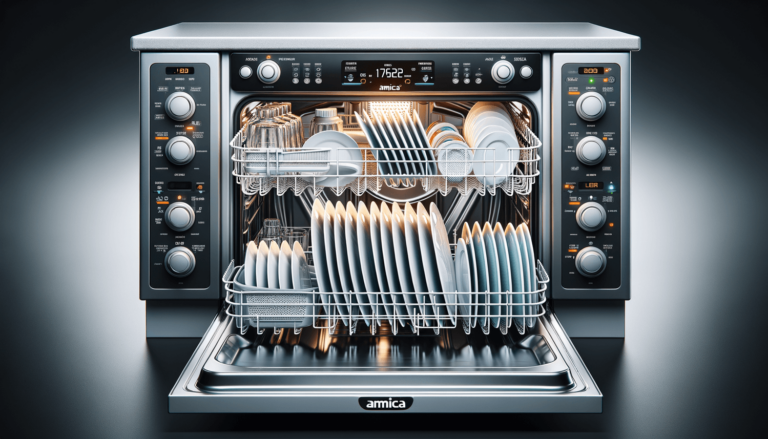

Do you own an Amica dishwasher or plan to purchase one soon? Familiarizing yourself with the vast array of settings and features available can help you optimize your dishwashing experience. In this blog post, we will demystify the various Amica dishwasher settings, simplifying your understanding and enabling you to effectively clean dishes the eco-friendly way. Are you ready to make the most of your Amica dishwasher? Let’s dive in!
The blog post ‘Amica Dishwasher Settings Explained’ aims to provide a clear and concise understanding of the various settings and features available on Amica dishwashers, helping users optimize their dishwashing experience and achieve effective and eco-friendly cleaning results.
Amica dishwashers are equipped with a variety of settings to cater to different dishwashing needs. Comprehending these dishwasher settings will allow you to maximize the appliance’s performance while conserving energy and water. Here are several key settings to understand:
This setting is designed to handle heavily soiled dishes, pots, and pans. It offers a high-intensity wash with increased water pressure and temperature, ensuring all stubborn food particles are removed. It’s recommended to use this setting for heavily soiled dishes that may require additional cleaning power.
The Eco Wash setting is an environmentally-friendly option designed to conserve water and energy while providing satisfactory cleaning results. It targets standard soiled dishes with a lower water temperature and pressure, extending the wash time slightly. Ideal for daily use, this setting helps decrease your carbon footprint.
For fragile items such as glassware and fine china, the Delicate Wash setting utilizes a low water temperature and gentle water pressure to carefully clean your dishes while minimizing the risk of damage. This setting is perfect for those precious items that require special care.
If you need clean dishes immediately, the Quick Wash setting is your ideal choice. This setting provides a rapid and efficient cleaning cycle that is suitable for lightly soiled dishes. It reduces the washing and drying time to deliver clean dishes quickly but may not remove stubborn food particles effectively.
Can’t decide on a dishwasher setting? The Auto Wash setting automatically senses the required cleaning level based on the soil load detected. It adjusts the water temperature, water pressure, and wash time accordingly, delivering optimal results with minimal intervention.
If you plan to run a full washing cycle later but want to prevent dried-up food from sticking to your dishes, the Rinse and Hold setting is perfect. This setting quickly rinses dishes without detergent and keeps them moist until the full washing cycle is initiated, making it easier to clean later on.
While understanding the primary Amica dishwasher settings is essential, there are other features and maintenance tips that can further improve your dishwashing experience. Here, we’ll discuss a few additional aspects, along with some valuable advice from Settings King, your go-to blog about technology settings.
If you have only a few dishes to wash but can’t wait for a full load, the Half Load option is your answer. This setting adjusts water and energy usage for a smaller load, saving resources without compromising the cleaning efficiency. Consulting advice from Settings King, this option is excellent for users who value both resource conservation and clean dishes in a timely manner.
Want to run your dishwasher during off-peak hours or while you’re asleep? Amica dishwashers come with a Delay Start feature, allowing you to schedule the dishwasher to start at a later time. This convenient feature, recommended by Settings King, can help save on energy costs and give you more control over your daily schedule.
To make the most of your Amica dishwasher settings, it’s essential to load your dishwasher correctly. Place large and heavy items on the bottom rack, with their dirtier sides facing the center, while delicate items should be placed on the top rack. Proper loading allows for better water circulation and improved cleaning performance, as recommended by the experts at Settings King.
Regularly maintaining your Amica dishwasher can prolong its lifespan and ensure optimal performance. Wiping the dishwasher’s interior occasionally, checking spray arms for clogs, and cleaning the filter are some advisable maintenance practices. As Settings King suggests, a well-maintained dishwasher leads to consistently satisfactory cleaning results and fewer technical issues down the line.
Implementing these tips and understanding your Amica dishwasher settings will enhance your dishwashing experience. Keep exploring informative articles from Settings King for more practical advice on technology settings to optimize your appliances and devices!
After reading our blog post about Amica dishwasher settings, you may have some questions that need further clarification. Below, we have compiled a list of common questions and provided concise answers to help you better understand the appliance’s settings and features.
The Eco Wash setting is ideal for everyday use, as it caters to standard soiled dishes while conserving water and energy, making it environmentally friendly.
Quick Wash can save time, but it only works best for lightly soiled dishes. For heavily soiled dishes or more varied loads, you should select a setting more appropriate for the level of soil, such as Intensive Wash for stubborn food particles.
Use the Delicate Wash setting for fragile items, as it offers gentle cleaning with low water temperature and pressure, minimizing the risk of damage to delicate objects.
Yes, you can use the Half Load option to adjust water and energy usage for smaller loads, saving resources without sacrificing cleaning efficiency.
While there is no strict maintenance schedule, it’s a good practice to occasionally clean the interior, spray arms, and filter to ensure optimal performance and extend the lifespan of your dishwasher. Regular maintenance can prevent technical issues and improve cleaning results.